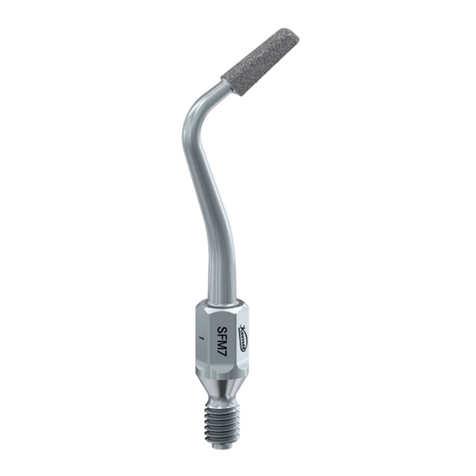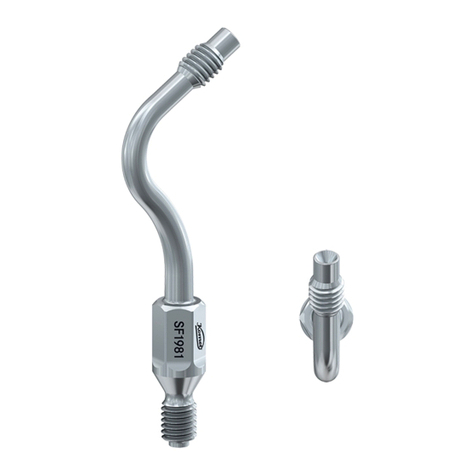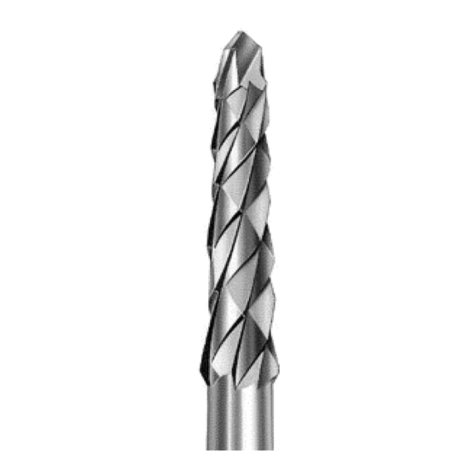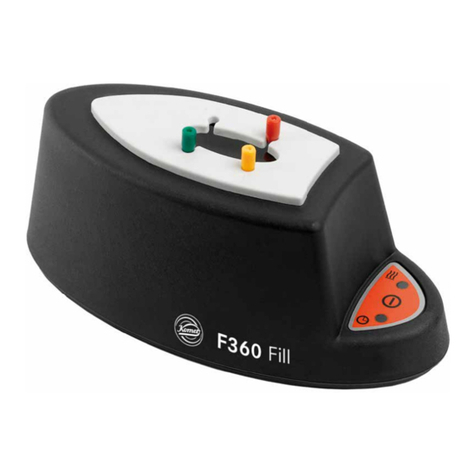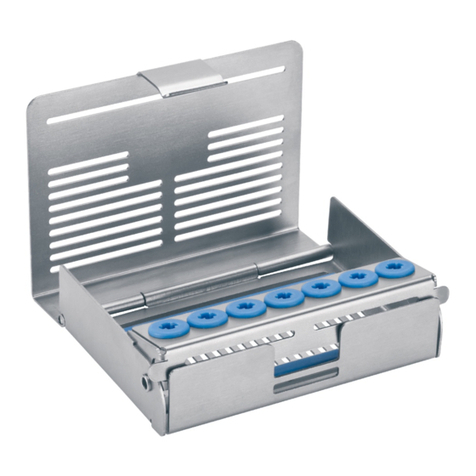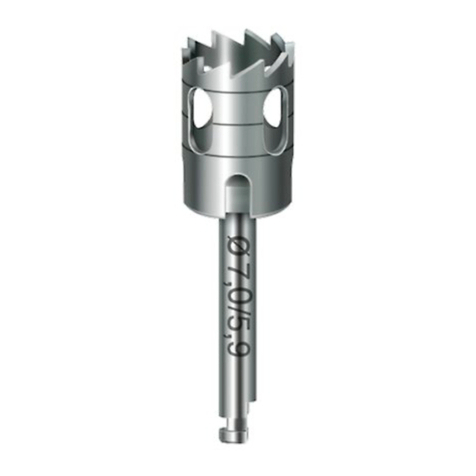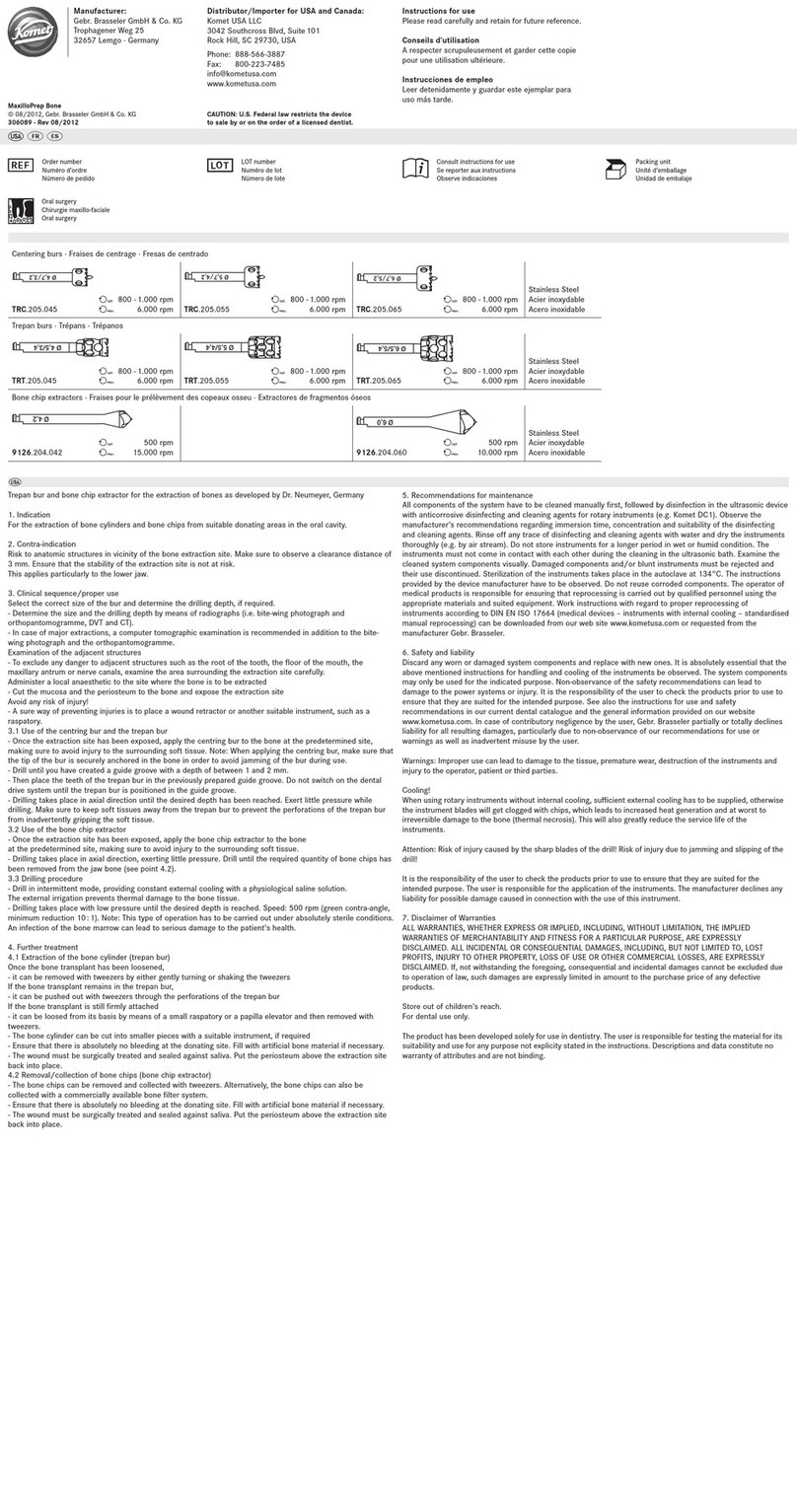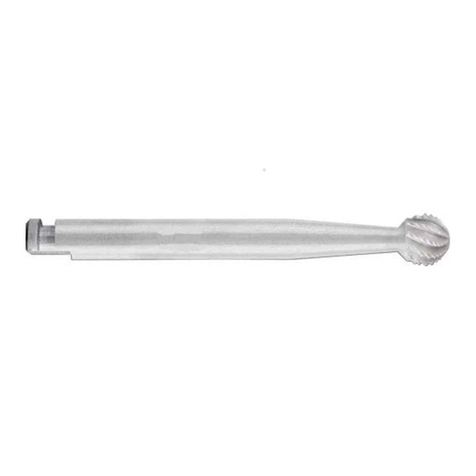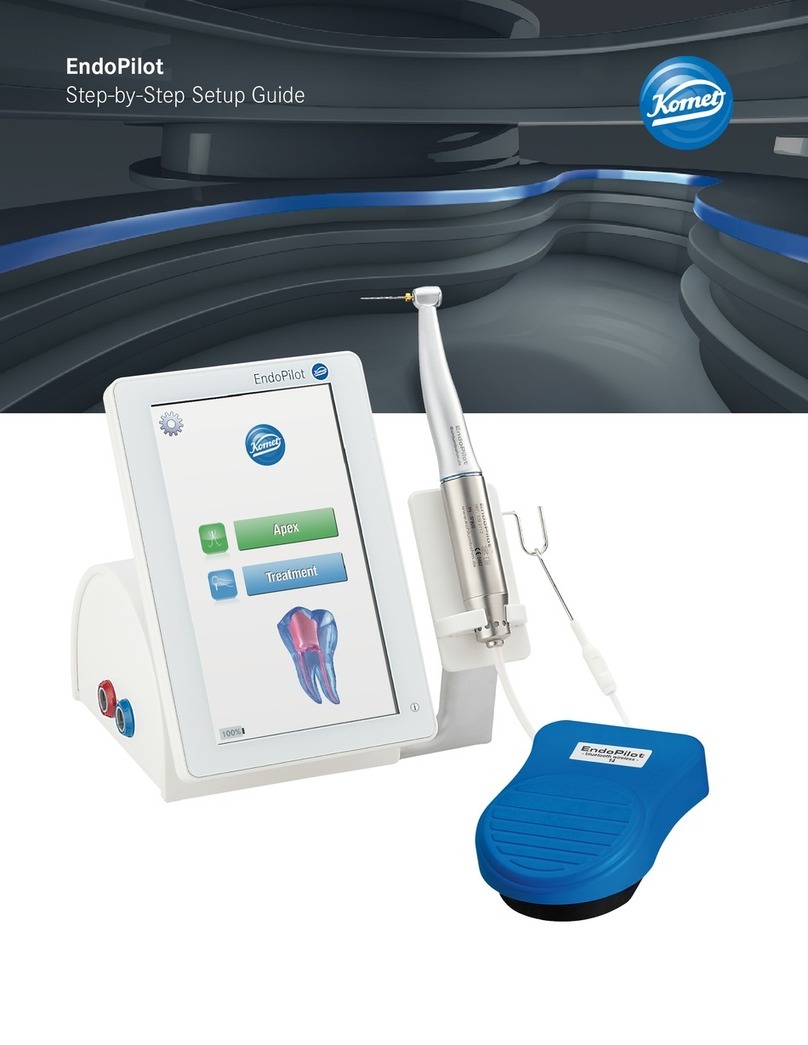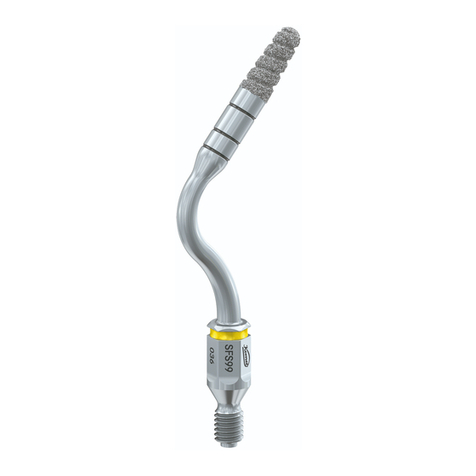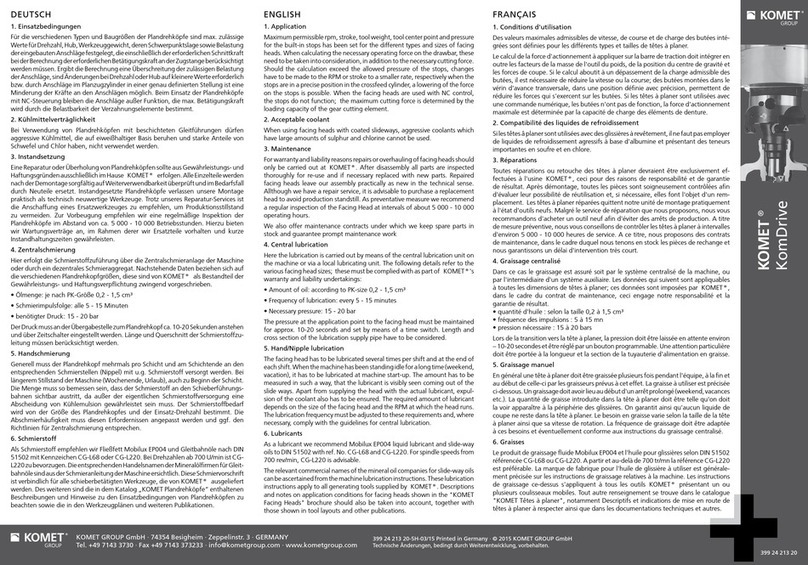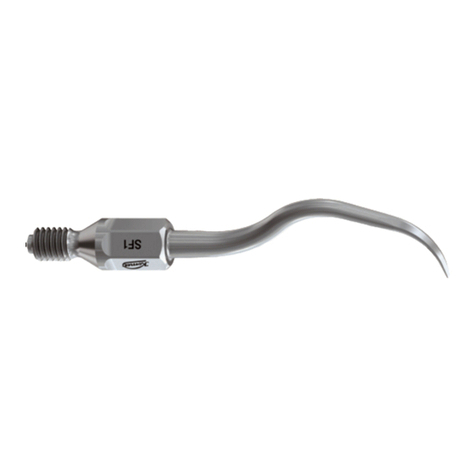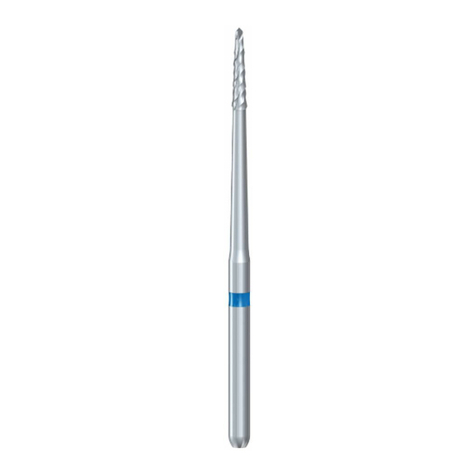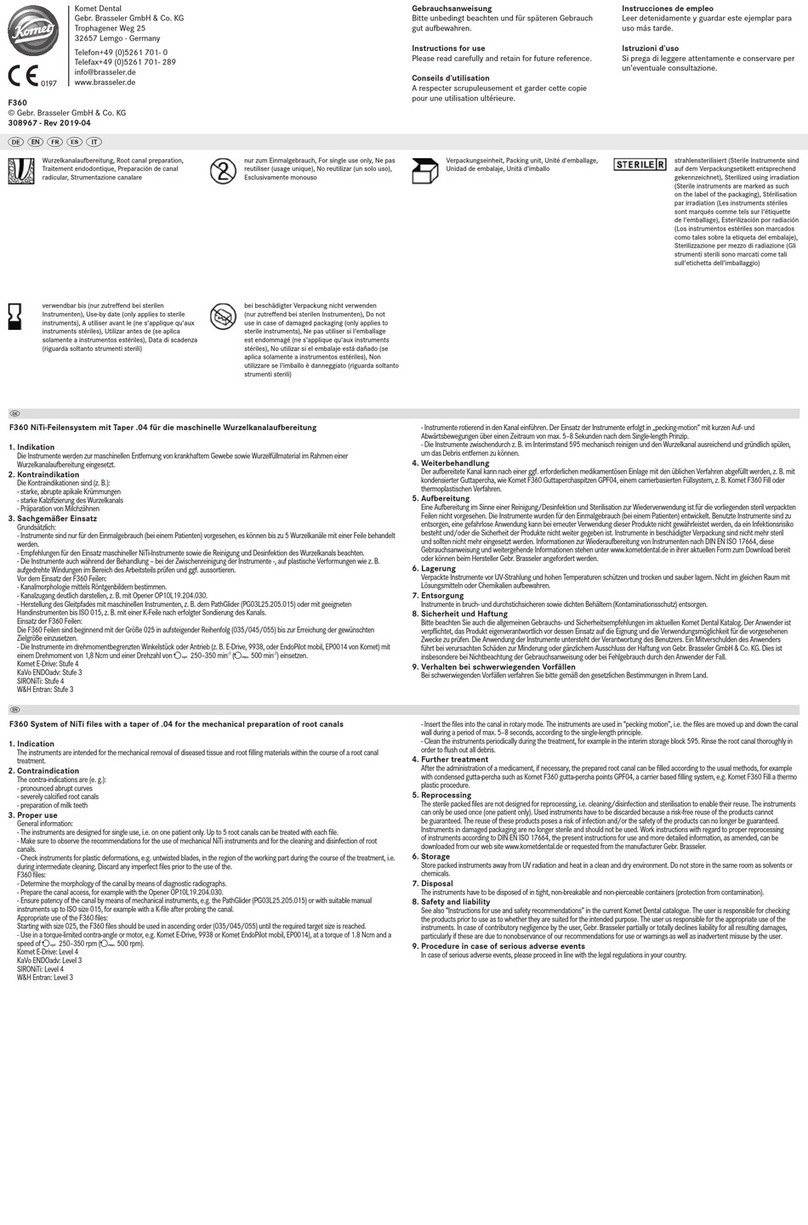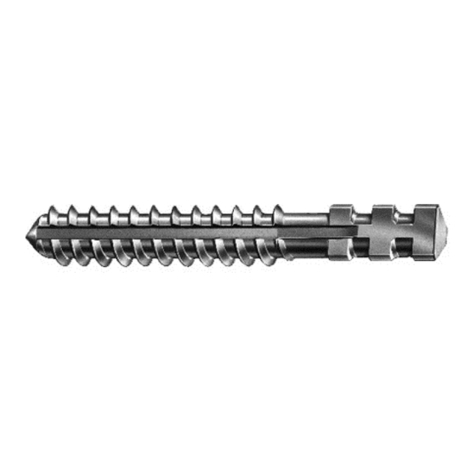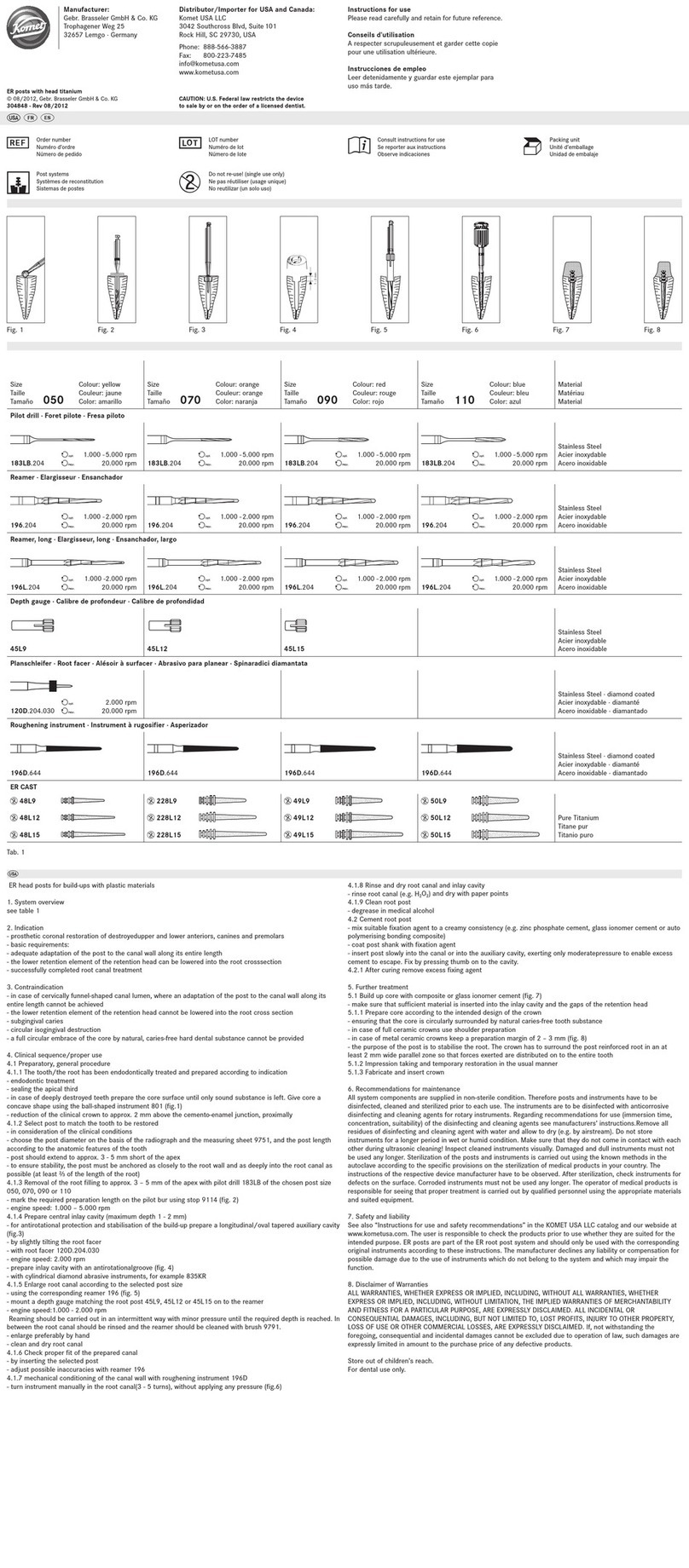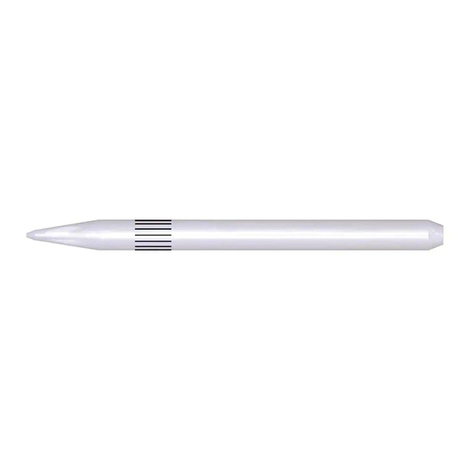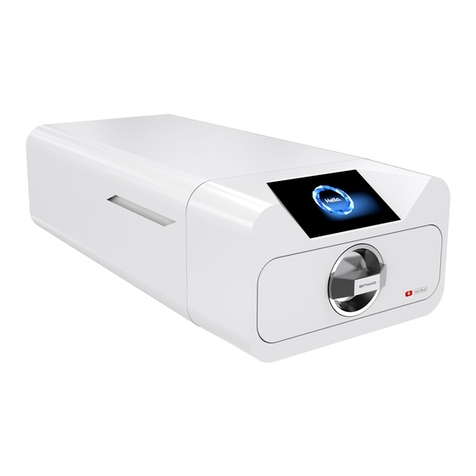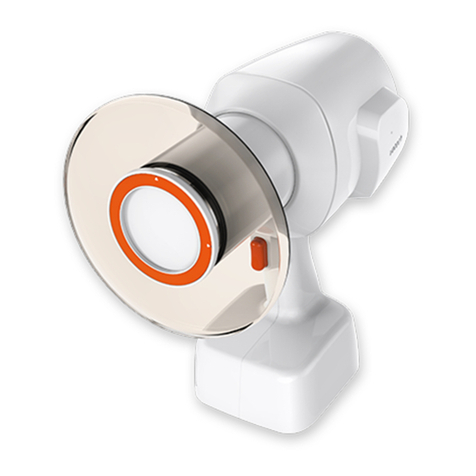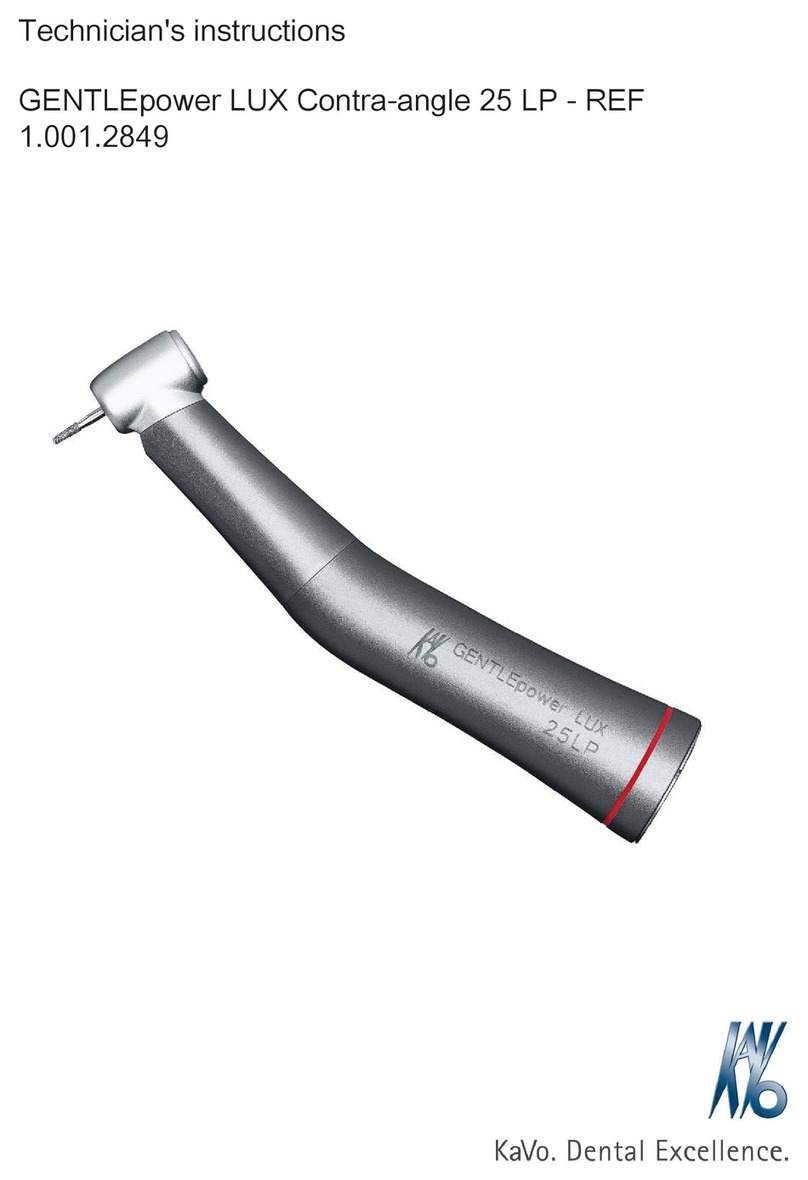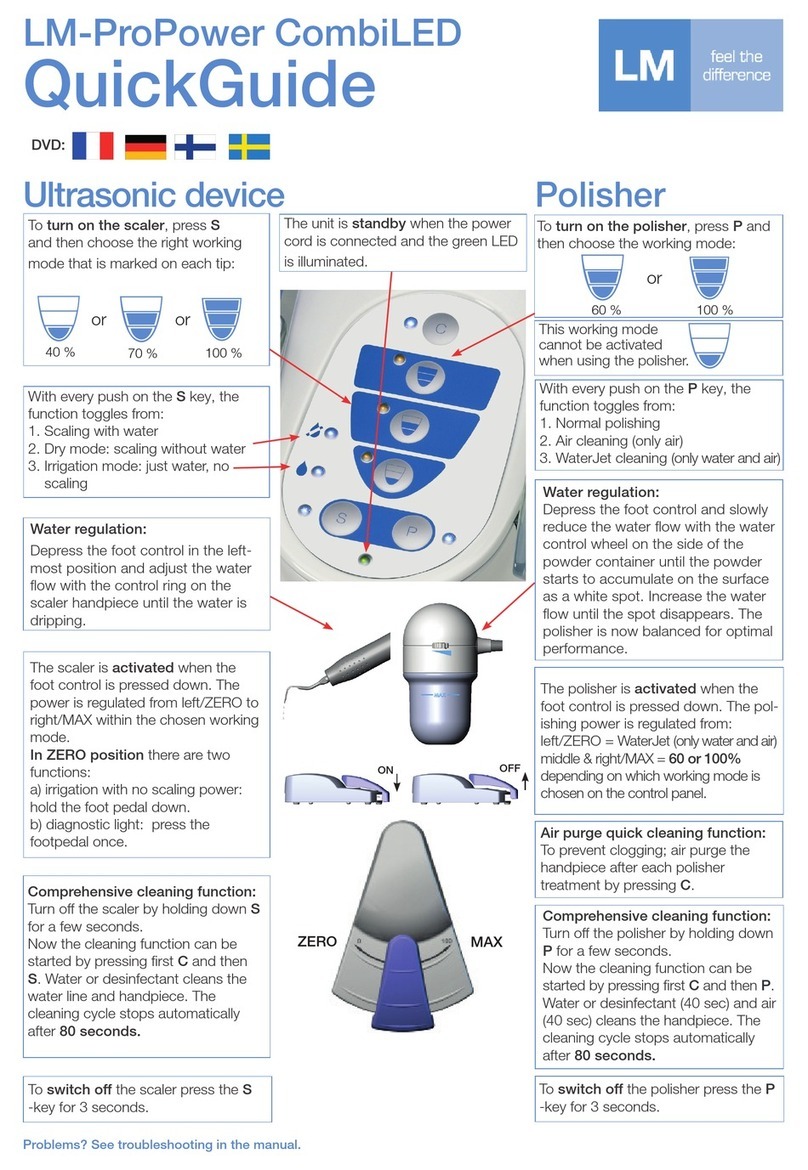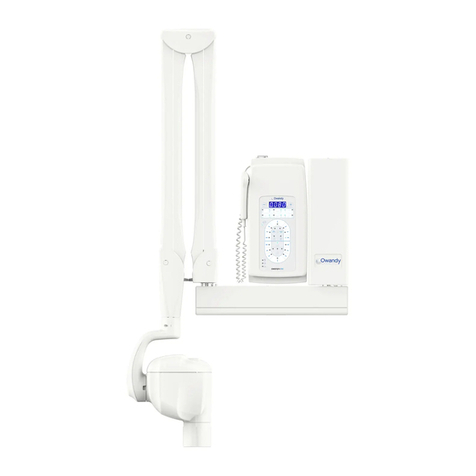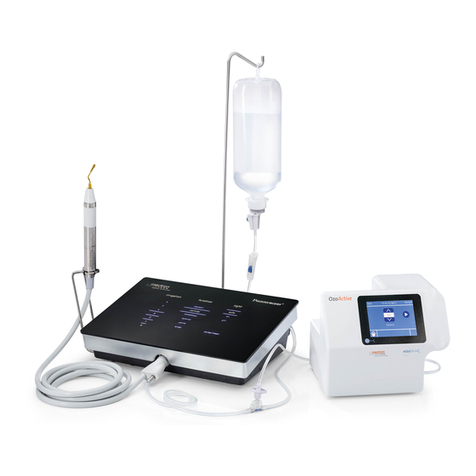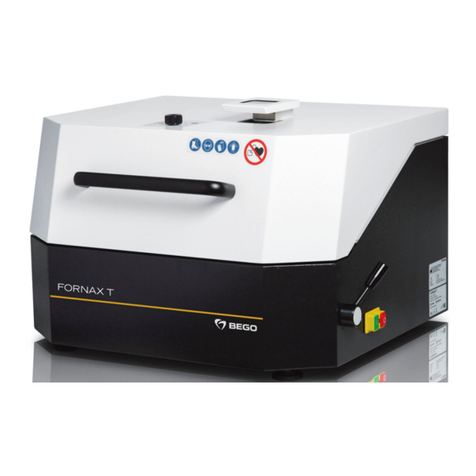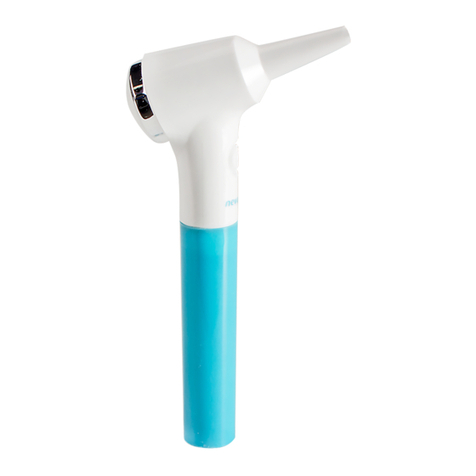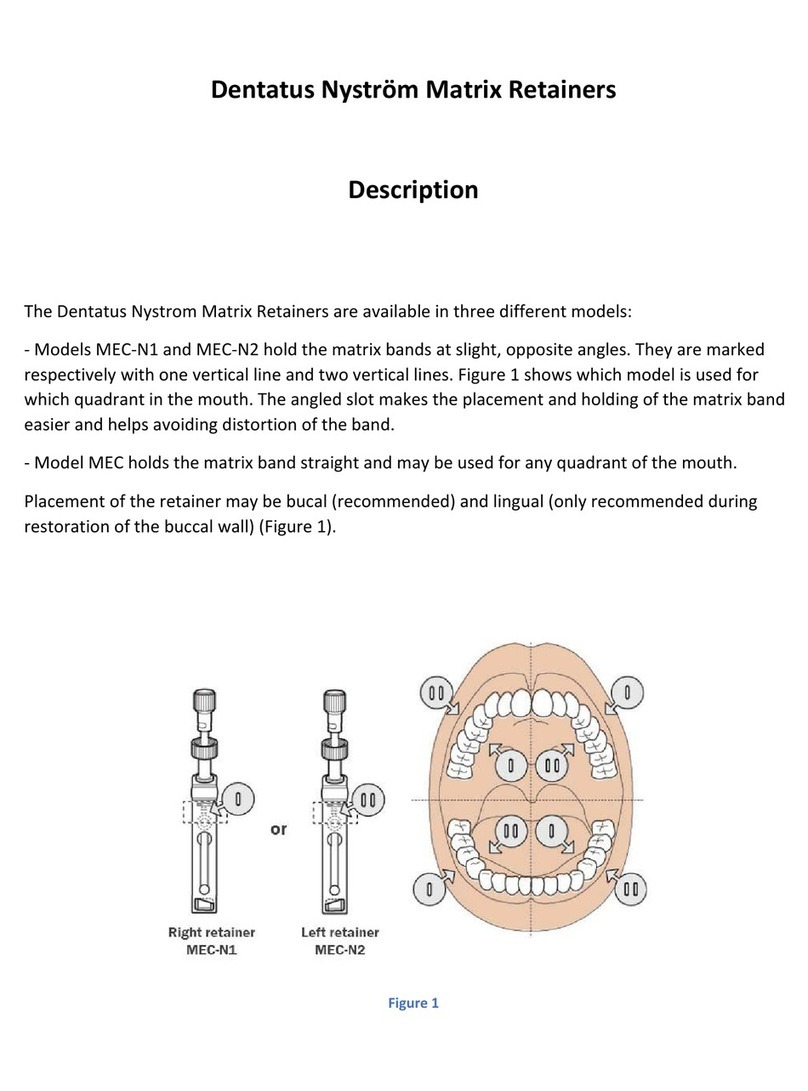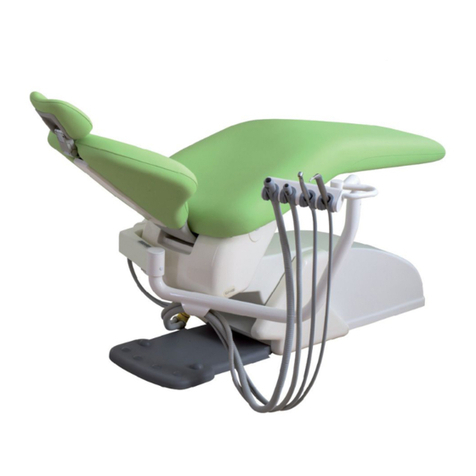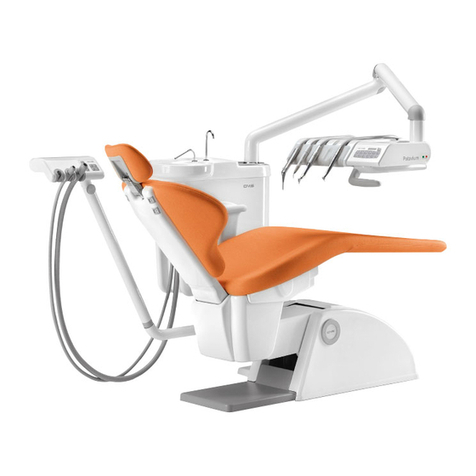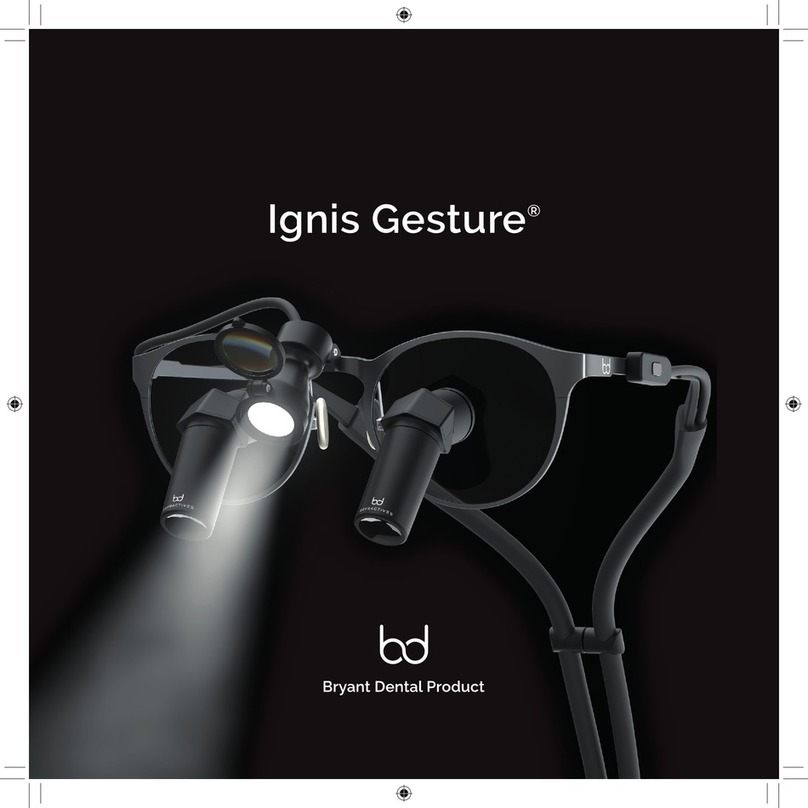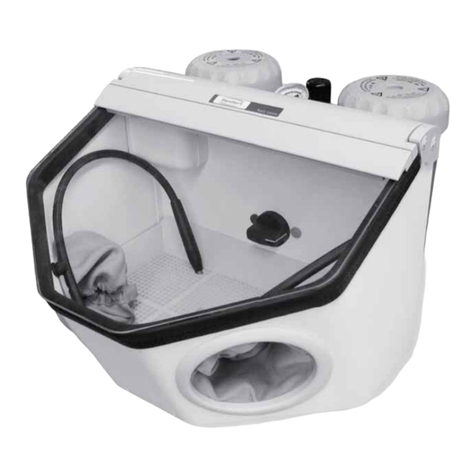
ê
ER DentinPost X pour la reconstitution des dents avec des matériaux plastiques
1. Eléments du système
voir tableau 1
2. IndicationsReconstitution prothétique des dents dont la couronne est détruite. Conditions générales :
- adaptation du tenon aux parois du canal radiculaire sur sa longueur totale
- l’élément de rétention inférieur de la tête rétentive peut être immergé dans la section transversale radiculaire
- traitement endodontique terminé
3. Contre-indications
- Un lumen canalaire cervical en forme d’entonnoir n’est pas approprié car une adaptation du tenon aux parois
du canal radiculaire sur sa longueur totale n’est pas possible
- L’élément de rétention inférieur de la tête rétentive (aillette cervicale) ne peut être immergé dans la section
transversale radiculaire
- Carie sous-gingivale
- Délabrement circulaire iso-gingival
- L’entourage circulaire du moignon dans la substance dentaire saine n’est pas possible
4. Déroulement du traitement/utilisation appropriée
4.1 Phases de traitement générales préparatoires :
- La dent et la racine ont subi un traitement endodontique initial et ont été préparées conformément à
l’indication.
- traitement endodontique
- remplissage/fermeture du tiers apical
- choisir le tenon selon la dent à reconstituer et la situation clinique
- à l’aide de la radiographie choisir le diamètre et la longueur du tenon selon l’anatomie de la dent.
- longueur du tenon jusqu’à environ 3 – 5 mm de l’apex
- pour des raisons de stabilité, le tenon (collant aux parois) doit être placé dans le canal aussi profond que
possible (⅔ de la longueur radiculaire au minimum).
- retirer l’obturation radiculaire jusqu’à environ 3 – 5 mm de l’apex avec le foret pilote 183LB
- taille du tenon choisie 050, 070, 090 ou 110
- marquer avec la butée la longueur nécessaire de la préparation sur le foret pilote (fig. 1)
- préparation de la cavité inlay centrale (profondeur maximale 1 – 2 mm)
- pour empêcher la rotation et pour stabiliser la reconstitution préparer une cavité ovale, conique (fig. 2)
- en inclinant légèrement la fraise à surfacer
- préparer la cavité inlay avec une rainure pour empêcher la rotation (fig. 3)
- avec des instruments diamantés cylindriques, p. ex. 835KR
- elargir le canal radiculaire selon la taille du tenon choisi
- avec l’élargisseur correspondant 196 (fig. 4)
- marquer avec le calibre de profondeur 45L9 ou 45L12 la longueur nécessaire de la préparation sur
l’élargisseur.
- elargir le canal avec peu de pression et de manière intermittente jusqu’à la profondeur désirée.
- rincer le canal et nettoyer l’élargisseur avec la brosse 9791 de temps en temps
- elargir le canal de préférence manuellement.
- rincer et sécher le canal radiculaire
- contrôler la bonne position en insérant le tenon choisi
- si nécessaire, éliminer des inexactitudes avec l’élargisseur 196
- effectuer une radiographie de contrôle, si nécessaire
- le tenon ER DentinPost X est visible à la radio (mais le contraste n’est pas aussi fort qu’en cas des tenons
céramiques ou métalliques)
4.2 Insertion du tenon et reconstitution
4.2.1 Rugosification mécanique de la paroi canalaire avec l’instrument diamanté 196D :
- Tourner l’instrument dans le canal radiculaire manuellement 3 – 5 fois sans pression (fig. 5)
4.2.2 Rincer et sécher le canal radiculaire et la cavité inlay :
- Désinfecter le canal avec NaOCl (hypochlorite de sodium)
- Eliminer la « smear layer » (couche résisduelle) avec de l’EDTA (acide éthylène-diamine-tétracétique). Rinçage
additionnel avec NaOCl.
- Sécher avec des pointes de papier
- Nettoyer la surface du tenon : dégraisser avec de l’alcool médical et sécher avec un jet d’air
- Utiliser la technique adhésive pour cimenter le tenon
- Conditionnement chimique de la dentine avec un agent adhésif (p. ex. ED Primer®, Kuraray) selon les
instructions du fabricant
- Recouvrir le tenon avec un composite autopolimérisant (p. ex. Panavia®F, Kuraray ou Rely XTM Unicem, Espe)
- Insérer lentement le tenon dans le canal radiculaire et la cavité d’inlay et le fixer avec peu de pression du
pouce
- Polymériser le composite et si nécessaire retirer l’excès d’adhésif
4.2.3 Compléter la préparation définitive :
- Adaptation du matériau de reconstitution plastique (p. ex. Clearfil Core®, Kuraray) selon les instructions du
fabricant (fig. 6)
- Polymériser et terminer la préparation définitive (fig. 7)
- Observer les principes suivants pour la préparation définitive :
- Veiller à ce que la couronne couvre le moignon circulairement
- Pour des couronnes entièrement en céramique, réaliser une limite de préparation du type épaulement
- La couronne doit couvrir la racine avec le tenon dans une zone parallèle d’au moins 2 mm, pour que les forces
excercées soient distribués sur la dent entière
5. Traitement ultérieur
- Porte d’empreinte et approvisionnement provisoire
- Produire et insérer la couronne
6. Conseils d’entretientTous les éléments du système sont livrés non-stériles
- Attention : Les tenons ER DentinPost X ne doivent pas être stérilisés. Pour cette raison, ils doivent être
nettoyés et désinfectés avec de l’alcool médical
- Traitement des instruments avant chaque utilisation : nettoyage, désinfection, stérilisation. Les tenons
radiculaires sont des produits à usage unique. La réutilisation de ces produits entraine un risque d’infection et/
ou la sécurité des produits ne peut plus être garantie.
- La désinfection et le nettoyage des instruments s’effectue avec des agents de désinfection et de nettoyage
anticorrosifs pour des instruments rotatifs. Respecter les indications du fabricant de produits de désinfection et
de nettoyage concernant le temps de trempage, les dosages et la compatibilité de matériau. Bien rincer les
agents de désinfection et de nettoyage résiduels et sécher les instruments (p. ex. par jet d’air). Ne pas stocker
les instruments à l’état humide. Veiller à ce que les instruments ne se touchent pas pendant le nettoyage dans
le bain à ultrasons ! Effectuer un contrôle visuel des instruments nettoyés. Ne plus utiliser les instruments
endommagés ou émoussés. La stérilisation des instruments s’effectue dans l’autoclave selon la méthode connue
et la réglementation pour la stérilisation des produits médicaux en vigueur dans le pays respectif. Observer les
conseils d‘utilisation du fabricant des appareils respectifs. Après la stérilisation, veiller au parfait état de surface
(corrosion). Ne plus utiliser les instruments corrodés. L’opérateur des produits médicaux est le responsable de
veiller à ce que le traitement des produits s’effectue par le personnel qualifié, avec les matériaux appropriés et
l’équipe correspondant.
7. Sécurité et responsabilité
Voir aussi les «conseils d’utilisation et de sécurité» dans le catalogue de Komet USA LLC et sur notre site
www.kometusa.com. L’utilisateur est responsable de vérifier avant chaque utilisation que les produits sont
adaptés à l’application spécifique. Les tenons DentinPost X font partie du système radiculaire ER et doivent
être uniquement utilisés avec les instruments d’origine de ce système, et ce conformément aux instructions.
L’utilisation d’instruments qui ne font pas partie de ce système peut être préjudiciable au bon fonctionnement
et exclut toute responsabilité du fabricant concernant la prestation à titre de compensations.
8. Exclusion de garantie
Toute garantie, expresse ou implicite, y compris, sans limitation, toute garantie implicite de commercialisation et
d’adéquation à un usage particulier, est expressément exclue. Toute responsabilité pour dommages indirects ou
fortuits, y compris de façon non limitative dommages pour perte de profit, dégradation de matériel, perte
d’utilisation ou toute autre perte commerciale est expressément exclue. Dans le cas où, nonobstant les faits
précités en vertu de la loi, les dommages Indirects ou fortuits ne peuvent pas être exclus, de tels dommages
seront expressément limités au prix d’acquisition du/des produits défectueux.
Ne pas laisser à la portée des enfants !
Réservé à l’usage exclusif du Chirurgien-Dentiste.
í
Pernos ER DentinPost X para la reconstrucción con materiales plásticos
1. Componentes del sistema
ver tabla 1
2. Indicaciones
Restauración protética de dientes con corona
clínica destruída. Requisitos generales:
- El perno debe adaptarse a la pared del canal a lo largo de toda su longitud
- La retención más baja de la cabeza de retención se apoya sobre el corte transversal de la raíz
- Tratamiento endodóntico terminado
3. Contraindicaciones
- En canales cervicales con lúmenes en forma de embudo no se garantiza una adaptación del perno a la pared
del canal en toda su longitud.
- La retención más baja (cervical) no se puede apoyar en el corte transversal de la raíz.
- Caries subgingival
- Destrucción isogingival circular
- Muñón que no esté rodeado circunferencialmente por sustancia sana del diente
4. Secuencia clínica/uso apropiado
4.1 Pasos generales preparatorios:
- El diente o la raíz han sido tratados endodónticamente y preparados según la indicación.
- Tratamiento endodóntido
- Sellado del tercio apical
- Seleccionar un perno que se adapte al diente considerando las condiciones clínicas
- Determinar el diámetro y la longitud del perno por medio de la radiografía del perno según la situación
anatómica del diente
- Longitud del perno hasta aprox. 3 – 5 mm antes del ápice
- Por razones de estabilidad, el perno debe instalarse en el canal radicular a la mayor profundidad posible y
adaptarlo precisamente a las paredes (mín. ⅔ de la longitud de la raíz)
- Remover la obturación radicular hasta aprox. 3 – 5 mm antes del ápice con la fresa pilote 183LB
- Tamaño del perno seleccionado 050, 070, 090 o 110
- Marcar la longitud de la preparación sobre la fresa pilote con el tope (fig. 1)
- Preparar la cavidad central para inlay (profundidad máxima 1 – 2 mm)
- Preparar una cavidad oval y cónica en forma de cajaita (fig. 2) para lograr mayor estabilidad.
- inclinando ligeramente la fresa para planear
- con la fresa para planear 120D.204.030
- Prepara la cavidad para inlay con una ranura de antirotación (fig. 3)
- Con instrumentos diamantados cilíndricos, p. ej. 835KR
- Ensanchar el conducto radicular adaptado al tamaño del perno elegido
- Con el ensanchador correspondiente 196 (fig. 4)
- Marcar la longitud de preparación sobre el ensanchador usando el calibre de profundidad 45L9 o 45L12
- Al ensanchar, hacerlo en forma intermitente y con poca presión hasta llegar a la profundidad deseada
- De vez en cuando debe irrigarse el conducto y limpiarse el ensanchador con cepillo 9791
- Es preferible ensanchar manualmente
- Limpiar y secar el conducto radicular
- Controlar el ajuste insertando el perno elegido
- Eliminar las interferencias con el ensanchador 196
- De ser necesario, hacer una radiografía de control
- El perno ER DentinPost X es radioopaco (pero el contrasto no es tan pronunciado como en caso de los pernos
de cerámica o metal)
4.2 Inserción del perno y reconstrucción
4.2.1 Acondicionamiento mecánico de la pared del conducto con el instrumento para asperizar 196D:
- Rotar el instrumento manualmente en el conducto radicular sin aplicar presión (3 – 5 rotaciones) (fig. 5)
- Irrigar y secar el conducto radicular y la cavidad para inlay
- Desinfectar con hipoclorito sódico (NaOCl)
- Eliminar la capa residual (smear-layer) con ácido etilendiaminotetracético o ácido cítrico (irrigar adicionalmente
con NaOCl)
- Secar con puntas de papel
- Limpiar la superficie del perno: desengrasar con alcohol medicinal y secar con chorro de aire
- Cementar el perno con el método adhesivo
- Acondicionamiento químico de la dentina con un agente para la adhesión dentinaria (p. ej. ED Primer®, Kuraray)
según las instrucciones del fabricante
- Recubrir el perno con un composite autopolimerizante o dual (p. ej. Panavia®F, Kuraray o Rely XTM Unicem,
ESPE)
- Insertar lentamente el perno en el conducto radicular y fijarlo con poca presión manual
- Polimerización del composite y si necesario remover el composite excesivo.
4.2.3 Terminar la preparación definitiva
- Adaptación del material plástico de reconstrucción (p. ej. Clearfil Core®, Kuraray) según las instrucciones del
fabricante (fig. 6)
- Polimerizar y completar la preparación definitiva (fig. 7)
- Para la preparación definitiva se deben observar las siguientes reglas:
- la corona debe cubrir el muñón de manera circunferencial
- Para coronas completamente de cerámica usar la técnica de hombros
- La corona debe cubrir la raíz reforzada por un perno en una zona paralela de un ancho de al menos 2 mm para
que las fuerzas sean distribuídas al diente completo.
5. Tratamiento ulterior
- Impresión y restauración provisional de manera habitual
- Fabricar e insertar la corona
6. Recomendaciones para el mantenimiento
- Todos los componentes del sistema se entregan sin esterilizar.
- Atención : Los pernos ER DentinPost X no son apropiados para la esterilización. Por esta razón, deben
limpiarse y desinfectarse con alcohol medicinal. Los postes radiculares son productos de uso único. La
reutilización de estos productos conlleva un riesgo de infección y/o la seguridad de los productos ya no puede
garantizarse.
- Tratamiento de los instrumentos antes de cada uso: Limpieza, desinfección y esterilización
- Los instrumentos deben limpiarse y desinfectarse con agentes de desinfección y de limpieza para instrumentos
rotatorios con anticorrosivo. Las recomendaciones de empleo (tiempo de inmersión, concentración, aptitud) de
los agentes de desinfección o limpieza se encuentran en las instrucciones del fabricante de estos agentes.
Irrigar bien los agentes de desinfección o detergentes con agua y secar (p. ej. con chorro de aire). No almacenar
los instrumentos en estado húmedo. Durante la limpieza en el baño ultrasónico los instrumentos no deben
tocarse unos con otros. Efectuar un control visual de los instrumentos. No deben utilizarse instrumentos
dañados o sin filo. Los instrumentos se esterilizan en el autoclave según los procedimientos conocidos y las
disposiciones para la esterilización de productos médicos específicos de su país. Deben observarse las
recomendaciones del fabricante de cada aparato. Después de la esterilización, controlar si la superficie de los
instrumentos muestra corrosión. Los instrumentos corroídos deben descartarse.El operador de productos
médicos es el responsable de ver que el tratamiento sea efectuado por el personal calificado usando los
materiales apropiados y el equipo correspondiente.
7. Seguridad y responsabilidad
Por favor, véase también las instrucciones para el empleo y las recomendaciones de seguridad en el catálogo
actual de Komet USA LLC así como las informaciones relevantes en www.kometusa.com. El operador tiene la
obligación de examinar los instrumentos. Es el responsable de comprobar – antes de utilizarlos – que su estado
sea el apropiado para el uso previsto. Los pernos DentinPost X forman parte del sistema de reconstrucción con
pernos ER y sólo deben usarse en combinación con los instrumentos originales según estas instrucciones. La
utilización de instrumentos que no forman parte de este sistema puede perjudicar la función y exonera al
fabricante de cualquier responsabilidad frente a compensaciones.
8. Exención de garantías
Todas las Garantías, ya sean expresas o implícitas, incluyendo, sin limitación, las garantías implícitas de la
comerciabilidad y aptitud para un propósito en particular, son expresamente denegadas. Todos los daños
incidentales o consecuenciales, incluyendo, pero no limitados a, pérdida de utilidades, daños a otro material,
pérdida de uso u otras pérdidas comerciales, son denegadas explícitamente. Si, no obstante la frase antes
mencionada, los daños consecuenciales e incidentales, no pudieran ser excluidos debido a leyes vigentes, el
valor de tales daños se limita expresamente al precio de compra o al valor de cualquier productos defectuosos.
Mantener fuera del alcance de los ninos.
Sólo para uso odontológico.
